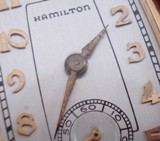This is a checklist for buying a vintage Hamilton watch. It applies to other manufacturers watches as well, such as Waltham, Elgin, Bulova, Illinois and so forth. If you’re new at this, then consider your goal for owning a vintage watch – is it for appearance sake?
Vintage watches don’t behave like ones made today. I wear two vintages watches. One is for everyday wear ( it’s a 1964 stainless steel wind-up). It’s simple, waterproof, anti-magnetic and looks nice. It’s not an automatic, self-winding watch.
My other vintage watch is a 1938 Hamilton Martin. It’s restored to look new. I know how to take care of it and it’s a sturdy timepiece. I have three other Martin models in case I need parts, another movement, a crystal and so forth. I called them my backups.
I could buy a new Hamilton, Omega or Tissot. I just don’t see the value in buying a new watch when I know how they’re made, the kind of generic movements they use and the manufacturer’s cost for the case.
That shouldn’t deter you from buying a new watch. Visit the websites for Hamilton, Tissot and Omega. You might find them more appropriate for your circumstances.
Does the movement run?
When was the last service?
Do you see any rust on the movement?
Does it have a popular caliber of movement, for example a Hamilton 987?
Are parts available?
How long does the watch run on one winding? – (Condition of the mainspring.)
 Case
Case
If gold-filled, has any of the gold rubbed off ? (Brassing)
How clean does the watch look? Is the crystal clear and minus scratches? (Look to see if replacement crystals are available.)
Is the crystal clear and minus scratches? (Look to see if replacement crystals are available.)
Does the face have more spots in one area than the others? (Probable leaking of the case seal.)
Does it come with a band and is it new? (You will discover that some watches like the Hamilton Cushion need very thin bands.)
Are the hands clean and without any rust?
Model
How popular is the watch? (For example, the Hamilton Martin is plentiful, which means an over-supply).
How detailed is the description? (Unless you are a restorer or know you models – you might be buying a $5 flea market special.)
Pricing and Value
Have you compared prices?
Is it a Buy It Now? (If so, it is more likely than not – overpriced and in worse condition than it appears in the photos.)
Does it have a high first bid? (Many buyers avoid high first bids, so you might be able to buy the watch cheaply at the last moment.)
Have you checked the seller’s ratings?
Did you first see it at the last minute and want to jump on it? (Don’t do that.)
Overall
Is the watch customized? (Has a seller changed the original appearance? For example, did someone have the dial painted colors the watch never came with? )
Has the seller given a date? (Ask where he or she got the information.)
Is the model name or number accurate and where did the seller find that information?
Research
Have you done a Google search and looked at the images on the browser tab?
Check out forums about the watch – you will find a great deal of information.
My advice is to know what you are doing and make sure the seller knows what he or she is doing. Chances are that they don’t. Try not to go with your gut feeling. Vintage watches are often fragile and don’t survive shipping. Add up to $300 plus parts to get it serviced.
Copyright 2006-2017 | All Rights Reserved
